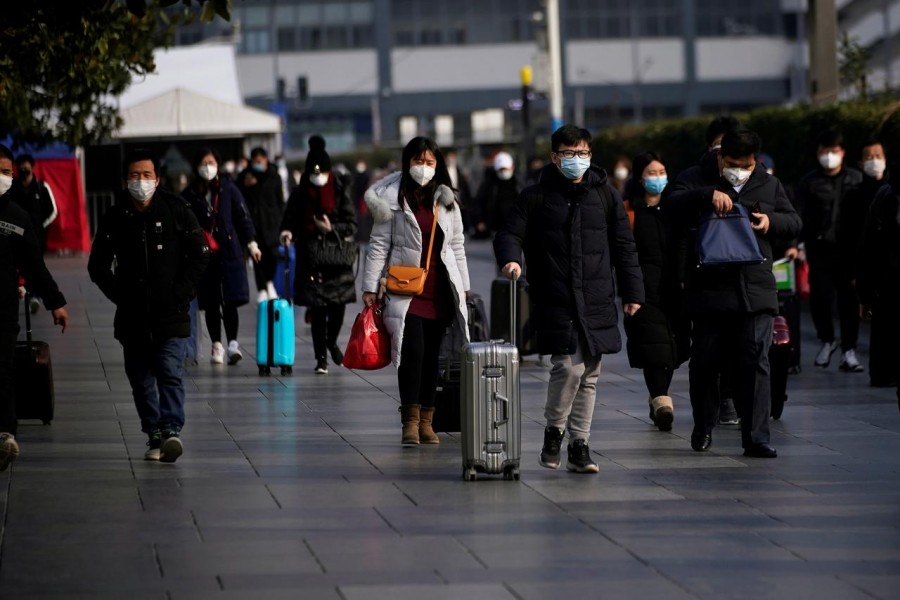Workers began trickling back to offices and factories around China on Monday as the government eased some restrictions on working in the wake of the coronavirus epidemic that has now killed more than 900 people, mostly on the mainland.
Sunday’s death toll of 97 was the largest in a single day since the outbreak was first detected in December at a seafood market in Hubei province’s capital, Wuhan.
Across mainland China, there were 3,062 new confirmed infections, bringing the total number so far to 40,171, according to the National Health Commission (NHC).
The epidemic has caused huge disruptions in China with usually teeming cities becoming virtual ghost towns during the past two weeks as Communist Party rulers ordered virtual lockdowns, cancelled flights, closed factories and shut schools.
Authorities had told businesses to tack up to 10 extra days onto Lunar New Year holidays that had been due to finish at the end of January.
Even on Monday, a large number of workplaces will remain closed and many white-collar workers will continue to work from home.
On one of the usually busiest subway lines in Beijing, trains were largely empty. The few commuters sighted during peak-hour morning traffic were all wearing masks.
Hubei, the province hit hardest by the outbreak, remains in virtual lockdow, with its train stations and airports shut and its roads sealed off. Some restrictions on people entering and leaving residential compounds are in place in many other cities across China, and schools in many regions will be shut through the end of February.
Rising toll rattles markets
Stocks and oil fell while safe-haven gold rose on Monday as the death toll from the coronavirus outbreak surpassed the Severe Acute Respiratory Syndrome (SARS) global epidemic in 2002/2003, raising alarm bells about its severity.
“Markets will be sensitive to coronavirus news as factories and ports in China reopen. The extent to which that is achievable will indicate the level of ongoing disruption,” ANZ economists wrote in a note.
The extended closure of factories in the world’s second-largest economy has raised concerns for global supply chains.
China’s central bank has taken a raft of measures to support the economy, including reducing interest rates and flushing the market with liquidity. From Monday, it will provide special funds for banks to re-lend to businesses combating the virus.
Taiwan’s Foxconn has received Chinese government approval to resume production at a key plant in the northern China city of Zhengzhou, a source with direct knowledge of the situation told Reuters on Monday.
About 16,000 people, or under 10 per cent of Foxconn’s workforce in Zhengzhou, have returned to the plant, the person said.
But the company, which makes smartphones for global vendors including Apple, is still in talks with the government to resume production at another plant in the southern Chinese city of Shenzhen, the source added.
Foxconn, formally known as Hon Hai, did not immediately respond to a request for comment.
Gaming giant Tencent Holdings said it had asked staff to continue working from home until February 21.
And Kia Motors is suspending production at its three car plants in South Korea on Monday for at least a day due to a shortage of auto parts from China related to the new coronavirus outbreak, a company official said.
WHO team heads for China
An advance team of international experts led by the World Health Organization (WHO) is heading for Beijing to help investigate the epidemic.
WHO director-general Tedros Adhanom Ghebreyesus, who made a trip to Beijing for talks with president Xi Jinping and Chinese ministers in late January, returned with an agreement on sending an international mission.
But it has taken nearly two weeks to get the government’s green light on its composition, which was not announced, other than to say that WHO veteran Dr Bruce Aylward, a Canadian epidemiologist and emergencies expert, was heading it.
The WHO declared the outbreak a global emergency on January 30, days after the Chinese central government imposed a lockdown on 60 million people in Hubei province.
The death toll from the outbreak in mainland China rose by 97, the largest in a single day so far, to 908 as of the end of Sunday.
Over the weekend, an American hospitalised in the central city of Wuhan became the first confirmed non-Chinese victim of the disease. A Japanese man who also died there was another suspected victim.
The virus has also spread to at least 27 countries and territories, according to a Reuters count based on official reports, infecting more than 330 people. Two deaths have been reported outside mainland China - both of Chinese nationals.
The latest patients outside China include a group of British nationals staying in a mountain village in Haute-Savoie in the Alps, French health officials said, raising fears of further infections across Europe.


